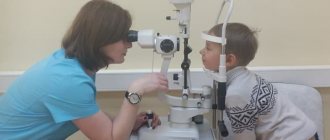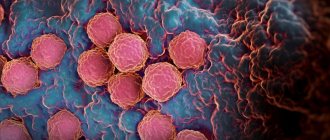Infectious disease specialist
Sinitsyn
Olga Valentinovna
34 years of experience
Highest qualification category of infectious disease doctor
Make an appointment
Until the 60s of the twentieth century, mumps (often called mumps in everyday life) was a widespread disease that almost every child had to endure. The disease is characterized by an acute course and primarily affects the salivary glands, causing characteristic swelling of the neck. Other organs and the central nervous system can be affected by the virus.
general information
The causative agent of mumps is the paramyxovirus Pneumophila parotiditis, which can only be carried by humans. In the external environment it is extremely unstable and is destroyed when:
- exposure to high temperatures - boiling, scalding, steaming, ironing;
- treatment with UV rays, including direct sunlight;
- drying;
- treatment with an acidic or alkaline environment, including a soap solution;
- contact with an aqueous solution of ethyl alcohol (at least 50%);
- treatment with formaldehyde solution (at least 0.1%) or other antiseptics.
The transmission of the virus from a sick person to a healthy person is carried out by airborne droplets; cases of household infection through objects or vertical infection - from mother to fetus during pregnancy - are very rarely recorded. Most often, mumps affects school-age children; children under 5 years of age and adults get sick much less often.
Effectiveness of vaccination
Until recently, mumps was widespread in the world: on average, from 0.1% to 1% (in some countries up to 6%) of the population had this disease. Modern features of the epidemiology of this disease are determined by the prevention of the disease carried out in many countries of the world using a live attenuated vaccine. In most countries of the world in recent years, the incidence of mumps is at a level of 100 to 1000 per 100,000 population with epidemic peaks every 2-5 years. The maximum number of cases occurs between the ages of 5-9 years.
As of January 1, 2014, the incidence rate in our country was 0.2 per 100 thousand people.
How to recognize an infection
Typically, two to three weeks pass between the moment of infection and the appearance of the first symptoms of mumps. During this time, the virus spreads in the body, affecting mainly glandular organs. 1-2 days before the manifestation of clinical signs, the patient may feel typical signs of infectious intoxication - headache, chills, malaise, muscle pain, a feeling of malaise and weakness, loss of appetite.
Penetration of the virus into the cells of the salivary gland leads to its inflammation, which is externally expressed in the characteristic swelling of the neck and post-auricular area. The tumor is accompanied by painful sensations that intensify when chewing and during conversation, as well as dry mouth due to deterioration of salivary function. The swelling persists for several days, and then gradually decreases and disappears. The total duration of the disease is two, less often three weeks.
Currently, up to 50% of cases of the disease are characterized by mild symptoms or an asymptomatic course. However, the patient, regardless of the presence of external signs, actively releases the virus into the environment and poses a danger to others. The risk of infection increases:
- in people who refuse vaccination;
- in spring and autumn due to a general decrease in immunity during these periods;
- with frequent colds;
- in patients undergoing a long course of treatment with antibiotics or hormonal drugs;
- in people with chronic diseases;
- with unbalanced, irregular or insufficient nutrition;
- if the rules of personal hygiene and quarantine precautions are not observed, especially during contact with a sick person.
The disease is characterized by high contagiousness; after illness or vaccination, stable, long-term immunity is formed. Mumps in children is quite mild, while adults tolerate the disease much worse: swelling of the salivary gland often persists for two weeks or even longer.
Are you experiencing symptoms of mumps (mumps)?
Only a doctor can accurately diagnose the disease. Don't delay your consultation - call
Vaccines
Currently, the mumps cultural live vaccine, associated mumps-measles divaccine, associated mumps-measles divaccine and associated mumps-measles rubella trivaccine are used to prevent mumps. After mumps vaccination, general normal vaccine reactions are rare and manifest themselves in the form of increased body temperature, redness of the pharynx, and runny nose. In rare cases, there is a short-term (within 1-3 days) increase in the parotid salivary glands (on one or both sides).
More about vaccines
Diagnostic methods
When a characteristic tumor appears, as a rule, the diagnosis of mumps comes down to confirming the clinical symptoms. In unobvious cases, the patient is prescribed:
- general laboratory tests of blood and urine;
- serological studies ELISA, RSK, RTGA;
- PCR test.
To identify antibodies, blood or other biological fluids are taken from the patient for analysis - throat swabs, salivary gland secretions or urine. The ELISA method allows you to detect the presence of the virus 2-3 days after the onset of the disease, while other tests give reliable results no earlier than 5-6 days.
Symptoms of mumps (mumps)
The disease usually begins acutely. The following symptoms appear:
- temperature (over 38°C);
- headache;
- general weakness, loss of appetite;
- pain while chewing or talking.
Towards the end of the first or second day of the disease, swelling occurs in the area of the parotid gland; the skin becomes stretched, touching this place is painful. Usually one gland swells first, and the next day or every other day the second one, on the other side, swells. The patient's face takes on a puffy appearance. The maximum increase in glands occurs on the third day, after which the swelling begins to subside and within a week the face
Complications of mumps
Severe forms of mumps are associated with damage to various organs by the virus. The pancreas, testicles in boys and ovaries in girls are most often affected. Mumps can lead to infertility. Another serious complication, which unfortunately occurs quite often, is meningitis.
Effective therapy for the disease
The main task of doctors in the process of treating mumps is to prevent the development of complications. The patient is prescribed strict bed rest for 10 days or longer, depending on the condition. Statistics show that if bed rest is not followed, cases of orchitis develop three times more often than in those who follow medical recommendations. In uncomplicated cases, the patient remains at home; hospitalization is necessary only if a severe complication occurs or to prevent further spread of the infection. It is important to provide the patient with proper care, including:
- drinking plenty of warm drinks to reduce intoxication by cellular decay products;
- liquid or semi-liquid food that does not require chewing;
- regular brushing of teeth and rinsing the mouth with boiled water or a weak soda solution;
- dry warm compresses on the tumor.
If complications develop, the doctor prescribes appropriate treatment according to the indications. Recovery occurs two to three weeks after the onset of the disease.
The most important factor in the prevention of mumps is the timely administration of a live vaccine to the child. Routine vaccination is carried out for one-year-old children with revaccination at 6 years of age. Older patients are vaccinated according to epidemiological indications. Statistics show that vaccinated children and adults get mumps much less often, and if infected, the risk of developing complications is significantly reduced.
Latest epidemics
In 2004–2010 There were outbreaks of mumps in England, the USA and Moldova, most often affecting teenagers. During an outbreak in the United States in schools for Orthodox Jewish children (3,500 cases), of those affected, 89% were fully vaccinated. It is believed that close contacts help overcome immune defenses. The outbreak was extinguished with the introduction of the 3rd dose of the vaccine.
In 2006, Russia recorded the lowest incidence rate of mumps in the entire history of observation - 1.64 per 100 thousand population. Compared to 1981, the incidence decreased by 294 times. The incidence of mumps has been steadily decreasing over the past five years, which was a consequence of the high level of vaccination coverage of children and especially revaccination from 72% in 1999 to 96.5% in 2006. As of January 1, 2014, the incidence rate in our country was 0.2 per 100 thousand people.
Complications
It is generally accepted that the worst consequences of mumps are deafness and male infertility. This is true, but that's not all. Mumps arthritis, meningitis and meningoencephalitis, heart disease, prostatitis, myocarditis, thrombocytopenic purpura and other systemic diseases are common.
After the disease ends, be sure to see specialized doctors: a cardiologist, urologist, neurologist.
Follow all the recommendations, and you will cope with mumps if it affects you. Yes, people’s susceptibility to this infection is high, but post-infectious immunity is stable and long-lasting.
Therefore, the most reliable way to prevent this unpleasant infection is vaccination. It can be held at the MC “Our Joy”
Consequences of mumps
With timely consultation with a doctor and timely treatment, the prognosis of the disease is favorable in most cases. However, mumps can cause a number of complications both during the height of the disease and at a later date.
The main complications caused by mumps infection are as follows:
- Testicular atrophy after bilateral mumps orchitis, which leads to infertility and eunuchoidism.
- Myocarditis (in most cases manifested by heart rhythm disturbances).
- Arthritis, arthralgia (mainly large joints are affected).
- Optic nerve damage.
- Hearing loss. It can be temporary, but permanent hearing loss is also possible, and with a bilateral process, complete deafness.
- Paresis.
- Neuritis of the facial nerve.
- Hydrocephalus due to impaired cerebrospinal fluid dynamics.
- Diabetes mellitus (after mumps pancreatitis).
- Nephritis.
This disease is extremely dangerous due to its complications, it can lead to disability and a significant deterioration in the child’s quality of life, therefore, at the first suspicion of this disease, you should consult a doctor.
Symptoms
The clinical picture of mumps, which occurs in adults and children, has almost the same manifestations. The only difference is that in adult patients the pathology is characterized by a more acute course.
There are three main symptoms of mumps:
- Hyperthermia – the body temperature of an infected person rises suddenly. The thermometer readings immediately reach critical values. At the same time, it is almost impossible to reduce the temperature with the help of medications in such a case. Although there is no need to worry about this - the immune system itself must eliminate the inflammatory process and produce antibodies to the virus. If the fever persists for a sufficiently long time after the other symptoms of mumps have subsided, then this already indicates the development of another disease.
- Swelling of the salivary glands behind the ears - this sign is the most striking evidence of the presence of mumps in a child or adult. The swelling is always large, the area is painful to the touch, and swallowing and chewing food is difficult. Due to the symptoms of mumps, the patient's appearance changes - the cheeks become larger and droop, and the earlobes rise slightly. These manifestations disappear 7-8 days from the start of therapy.
- Poor health and weakness - children infected with mumps are usually lethargic and indifferent. In adults, the disease is more severe; they suffer the disease while lying down. Often with this pathology, patients are irritated by extraneous sounds, photophobia and headaches occur.
Treatment
Mumps in children is usually treated at home and hospitalization is not required. The pediatrician will prescribe treatment. As a rule, these are: antiviral drugs, antihistamines, vitamins, and situationally - analgesics and antipyretics. Antibiotics are prescribed only if complications develop.
Caring for a child with mumps.
- be sure to isolate the child from non-ill children and relatives, especially from pregnant women;
- use separate dishes and bed;
- frequently ventilate the room and do wet cleaning with disinfectants every day, preferably twice a day;
- the possibility of quartzing a room - an additional way to fight the virus;
- toys should be limited to those that are easy to clean;
- strict bed rest to avoid complications, especially in boys;
- diet: drink plenty of fluids up to 2 liters per day, completely avoid fried, fatty, sour, and spicy foods. Place your bet on plant and dairy products, rice, potatoes.









